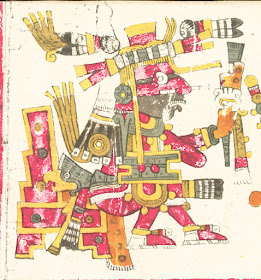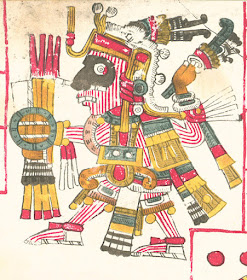They make the cruel Assyrians and Genghis Khan look like human rights activists. The Aztecs conjure up words of blood lust, human sacrifice, and heart plucking. They are brutal, but after reading the 18 Months in a year of the Aztecs based on the Florentine Codex, the level of horror just goes up. Following 18 months and the rituals involved are: 
Tlaloc, one of the major Aztec deities
9. Tlaxochimaco
The Aztecs dedicated this month to the major god Huitzilopochtli. A period where flowers once again flowed. A period where slaughtering focused more on animals rather than humans.
During the month’s festival, the populace slaughter fowls and dogs. They then offered flowers first to Huitzilopochtli then to other deities. After this, they cooked and ate the animals slaughtered last night before another round of dancing and singing.
Huitzilopochtli
10. Xocotl Huetzi
Attention for this month went to the fire god Xiuhtecutli aka Ixcozauhqui. No prize for guessing on the method of sacrifice. All events amidst erected and well-decorated poles.
The Aztecs then set up ceremonial poles to celebrate the fire god. They cut down trees and erected them in the courtyard of the temple of Xiuhtecutli. They then smoothened the surface and decorated it with paper and ropes.
Alongside the decoration of poles, slave-owners also decorated their slaves, accessorizing them and coloring their skin yellow. They prayed and danced during the festival before bringing their sacrifice to the temple.
After lining up the sacrifices, the presiding priest blew a power called yiauhtli which meant to numb the senses of the sacrificial slaves. The Aztecs then carried the numb slaves into their shoulders and brought them to a great fire made by coal. In great fanfare, the carriers threw into the fire the slaves who then greatly suffered before in brink of death to be pulled out and dragged into the sacrificial table. A priest then tore into the burned slave’s body and plucked the heart out.
Xiuhtecuhtli
11. Ochpaniztli
The month’s feast went to the Grandmother goddess, Teteo Innan or Toci. A period of silent worship and celebration. Yet another sacrifice of a clueless woman.
The month began with 8 days of dancing in complete silence followed by 4 days of female doctors and midwives dividing themselves into 2 groups. After which they threw against each other balls made out of tuna cactus and tree parasites alongside flowers called cempoalxochitl. By the end of the ball fight, they then looked for a woman to represent the goddess to be sacrificed in complete ignorance of her ultimate fate.
They went to the woman to be sacrificed and told her that she was to sleep with a great lord. They did not notify her of the upcoming ritual as she cannot cry or sad as it meant a terrible omen. Masqueraded as a preparation for the meeting, they covered her with accessories and ornaments before being brought to the top of the pyramid.
Here, a priest then took the woman in his back. In such a position, another priest swiftly beheaded the woman then flayed the body and the skin to be worn by a stout youth. This stout youth then paraded the skill amidst jubilation up until the pyramid of Huitzilopochtli. 4 POWs waited on top of the pyramid to be sacrificed by the skin-clad youth.
12. Teotlehco
All gods celebrated this month. A month filled with merry and feast. The main event involved a cake and an impression that brought more joy as if a new Pope just got elected.
The month saw feasting, dancing and singing, but the main event on the last day of the month involved a small cornmeal cake that the chief priest guarded all night. The priest waited for an impression of a footprint.
And just like a white smoke from the Sistine Chapel followed by the declaration “Habemus Papam”, the priest once found a footprint in the cake, the priest cried “Our Lord had come” and the news heralded amidst sounds of various instruments. Unfortunately for captives lined up that day, the announcement signaled their mass burning as a sacrifice.
13. Tepeilhuitl
A month dedicated to the appreciation of mountains. The month also witnessed the creation of effigies of the dead. The highlights involved with the sacrifice of 4 women and a man.
The Aztecs made ecatotonti, wood or roots carved into the form of serpents. On top of it laid a dough called tzoalli. Following this a figure placed on top symbolizes those who passed away by drowning. They then offered food, especially tamales.
After the commemoration, 4 women and a man prepared to be sacrificed. Each of them played a role. For the women, the Aztecs called them Tepexoch, Matlalcueie, Xochtecatle, and Mayauel. The man called Minauatl and together they got covered by paper lined with rubber. They then went to the pyramid to be slain and hearts taken.
Their cadavers then fell off the stairs of the pyramid. After which their heads were taken and mounted to pikes. Their mutilated bodies on the other hand got eaten.
14. Quecholli
The month saw dedication to the god Mixcoatl, the god of hunting. No surprises that the month involved a hunting celebration. Once again it also witnessed the sacrifice of impersonators of the god and his consorts.
The month’s festivities began in a temple were men made arrows for 5 days and each of the arrows smeared by blood from their ears. They then offer 4 torches with small arrow or darts to the dead along with tamales.
During the main feast day, the Aztecs then went to Cacatepec where they built huts before going on a hunt. After the hunt, they also brought POWs and slaves to Tlamatzinco. Here, they bound the foot and hands of the victims as well as that of the captured deers from the hunt. All slain in the name of the gods. Finally, a man and a woman representing Mixcoatl and his consort went to the pyramid Micoateopan to be sacrificed.
 |
| Mixcoatl |
15. Panquetzaliztli
Another month of dancing and chanting in honor of Huitzilipochtli A celebration of war, of competition, and of course blood. A whole city wide celebration.
The 9th day of the month witnessed sacrifices of slaves adorned and painted in various colors. A sneak peak of the sacrifices at the end of the month.
When that day came, an accessorized priest sacrificed 4 slaves in the ball court of Teotlachtli. After which he went on a run across the city with the route having pit stops where he sacrificed more slaves to the war god. At the end, a mock battle began and more sacrifices saw their ends on top of Hutzilipochtli’s pyramid.
16. Atemoztli
Another month for Tlaloc. A month of another round of rituals and festivities but no blood sacrifices.
17. Tititl
This month saw the celebration of the god Ilamatecutlo or Tonan or Cozcamiauh. Another impersonator saw her end. The month also witnessed a massive pillow fight.
An impersonator of Tonan celebrated while men played music. In the end of all the performances she should weep because of her ultimate fate of death. During D-Day, the priest ushered her to the top of the pyramid and into the sacrificial table. They stretched out the woman before mutilating her body to grab her heart. They then beheaded the body pulling up the head by the hair at which the crowd started dancing.
After the sacrifice, men and women filled sacks with wool and began hitting each other in an apparent mock battle.
18. Izcalli
Another month for the god of fire Xiuhtecutli. This saw the training of young boys in hunting and an olympic-period like sacrifice.
During this month, for 10 days, teenage boys went hunting. They then offer to the elders the animals they caught and have them cooked. The elders then gave the boys tamales with amaranths called uauhquiltmalli. Also, they pierce the ears of boys and girls and adorned in their heads a wig of parrot feathers, like a right of passage.
No sacrificial killing happened during this month, but every 4 years, a sacrifice occurred. An impersonator of the the fire god Xiuhtecutli got sacrificed. After which, the population including the Emperor danced the netecuitotiliztli.
A Calendar of Horror? The Aztec Veintena - Part 1
Source:
Sahagun, Bernardino. General History of the Things of New Spain. Translated by Arthur Anderson & Charles Dibble. Salt Lake City, Utah: University of Utah Press, 1981
No comments:
Post a Comment
Note: Only a member of this blog may post a comment.